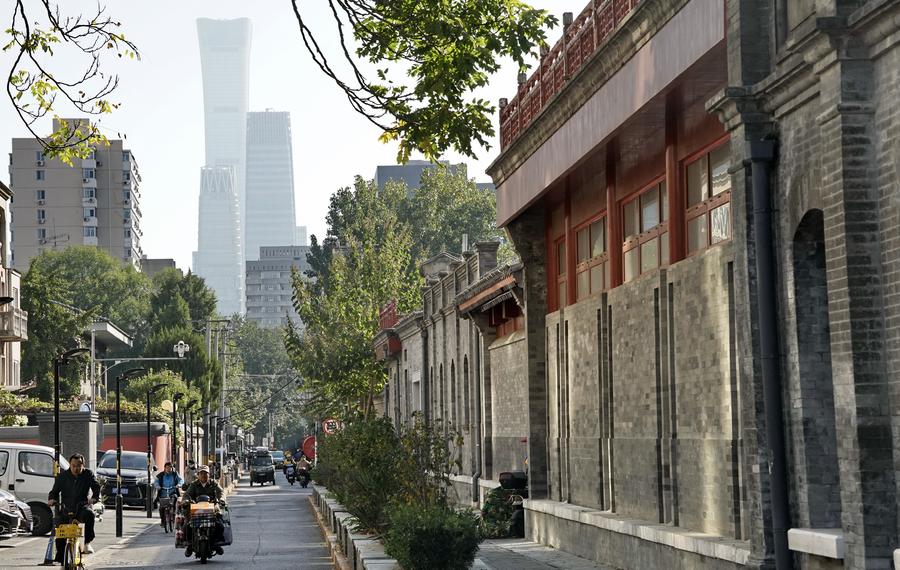
 0 Comment(s)
0 Comment(s) Print
Print E-mail Xinhua, October 21, 2024
E-mail Xinhua, October 21, 2024
This photo shows a hutong after renewal in the Chaoyangmen South and North streets area in Beijing, capital of China, Oct. 15, 2024. [Photo/Xinhua]
Walking through the Chaoyangmen South and North streets spanning 2.8 km in downtown Beijing, clean streets adorned with delicately designed miniature gardens, well-refurbished restaurants and convenience stores bustle with life as residents bask in the sun on a late autumn day.
First established in ancient China's Yuan Dynasty (1271-1368), the streets over 700 years old have defied age by constantly renewing themselves, where businesses are thriving and original residents and newcomers mingle and pursue life and work goals.
Not far away from the neighborhood is Qianmen, a hotspot for tourists. From here, the attention-catching antique buses called "dang dang che" move slowly as tourists on these buses enjoy learning about the history and culture of the Beijing Central Axis, a newly recognized UNESCO World Heritage Site.
As the refurbished antique bus travels on its routine path, modern clean-energy double-deckers and dual-carriage buses hurtle by, conjuring up a city image that showcases both the history and modern-day development of Beijing.
As China's political and cultural center, the city receives people from around the world for important meetings and its many historical attractions such as the Forbidden City and the Great Wall. But apart from that, the megacity with a population of around 22 million is also one of the most modern, vibrant, and technologically advanced Chinese cities, providing a window to look at and digest the historical changes brought about by economic and social development in China.
Ancient city with renewed image
In the Chinese capital, clean energy public buses accounted for nearly 95 percent of the city's public buses as of the end of 2023, per capita GDP ranked first compared to other Chinese regions and people's average life expectancy reached 82.51 years in the same cited year, according to data from local authorities.
A hydrogen-powered bus runs on a road in Daxing Distrcit of Beijing, capital of China, Aug. 20, 2024. [Photo/Xinhua]
For An Zhifeng, a resident living in the Chaoyangmen South and North streets area, her life after retirement focuses on leading a healthy lifestyle. "The streets have become wider and more beautiful now. There are seats everywhere along the streets and we can sit down for some rest after a walk or exercise."
An was referring to an already completed urban renewal project for the streets that started at the end of 2023, through which the functions of the streets were analyzed and redesigned by removing traffic barriers that used to be set up to prioritize fast-moving vehicles, setting up new slow-traffic lanes for the passage of pedestrians and bicycles, and renovating municipal facilities to improve the streets' image and residents' life quality in the area.
"Before the renewal, the hutongs were very narrow and residents parked cars in quite a limited space, and they often quarreled for parking. With this newly built multi-level parking facility in our neighborhood, we have more parking lots and it helped strengthen the harmony and unity within our community," said Jiang Xiuping, another resident.
Sun Yang, deputy head of the Dongcheng district government, said that the renewal project lasted for nearly a year, and is an example of Beijing's practice in upholding the "people's city" concept and responding to the people's needs.
The changes in Chaoyangmen South and North streets epitomize city-wide urban renewal projects conducted across various districts based on local conditions. In terms of urban renewal, data from the Beijing municipal government shows that the city has completed the renovation of 565 residential communities from 2021 to 2023, with more such projects being carried out.
The city also promotes digitalization and green transformation for major projects during urban renewal. For instance, the Liangma River region in eastern Beijing's Chaoyang district has become a bustling commercial hub for its robust night activities and light shows, while the Beijing South Central Axis Culture and Innovation Park in Fengtai district, once the site of a major clothing wholesale market, has now transformed into a hub where high-tech firms gather.
A boat sails in the Liangma River in Chaoyang District of Beijing, capital of China, March 16, 2024. [Photo/Xinhua]
Global high-tech hub ambition
Apart from its roles as China's political, cultural and international exchange centers, the city also aims to become a hub for key engines driving high-quality development as well as a global hub of science and technological innovation.
The Dongsheng Industrial Park in the city's Haidian district is a hub where high-tech firms concentrate. "After years of development, Dongsheng Town is now home to nearly 4,000 enterprises, including 1,879 technology enterprises, 16 listed enterprises, and 7 unicorn enterprises...the advantages of large-scale industrial agglomeration are significant," according to Ren Yiding, deputy mayor of the town.
With its success in electric mobility products, the Ninebot company based in the park has in recent years developed products such as smart lawn mower robots that meet the user needs in the global market. "The lawnmowers have been exported to European and American markets and are well received, further establishing the Made-in-China brand," said Gao Lufeng, founder and CEO of Ninebot.
Go to Forum >>0 Comment(s)